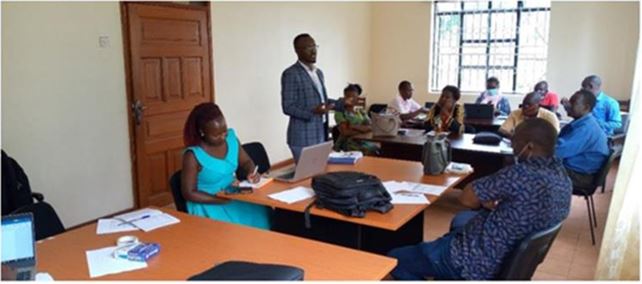
Training District Health Teams on Developing and Interpreting Malaria Normal Channels to Detect Malaria Outbreaks in Jinja Region, Eastern Uganda
Quarterly Epidemiological Bulletin : July to September 2020 Volume 5 Issue 3 Article No. 8 | Authors: Ignatius Wadunde1*, Richard Migisha1, Immaculate Akusekera1, and Lilian Bulage1| Affiliation: 1Uganda Public Health Fellowship Program, Kampala, Uganda
Background
Malaria remains a major Public Health problem causing 30-50% of outpatient visits, 15-20% of admissions, and up to 20% of all facility deaths in Uganda. It is the most frequently reported disease at both Public and private health facilities. In 2019, there was a malaria upsurge in the majority of districts in Uganda which was detected late due to failure to analyze surveillance data both at the district and national level. We set out to train the district health team, health facility in-charges, and their respective records focal persons on surveillance and developing and interpreting malaria normal channels in the districts of Kamuli, Buyende, Kaliro, Luuka and Bugweri to build capacity to detect malaria outbreaks in Uganda.
Methods
We used a case study entitled, “Uganda PHFP 2019: Analysis of surveillance data (2014-2019)”, developed by Uganda Public Health Fellow- ship Program in 2019 to train the district teams on surveillance and how to develop and interpret a malaria normal channel. The case study training objectives include; to discuss the importance of routinely analyzing disease surveillance data, conduct a descript analysis of surveillance data, interpret the findings of descriptive analysis of surveillance data, describe the importance of malaria normal channels in detecting malaria outbreaks, draw a malaria normal channel and interpret a malaria normal channel.
The training was a practical session with hands-on sessions on computers/laptops. The practical sessions involved among other things drawing of the malaria normal channels based on real malaria data for Mbale District and national data obtained from the DHIS2 and embedded in the case study. The step by step instructions provided in the participants’ guide was followed to construct the malaria normal channel.

Achievements
The team trained a total of 49 DHT members from five districts of Kamuli (10), Kaliro (10), Buyende (9), Luuka (10), and Bugweri (10). At the end of the training, all the participants of the five districts trained were able to plot and interpret a normal malaria channel graph.
Of the 49 DHT trained, 04 were District Health Officers, 05 were Assistant District Health Officers-Maternal and Child Health, 03 were Assistant District Health officers-Environmental Health, 05 were Biostatisticians, 05 were District Surveillance Focal Persons, 04 were Malaria focal persons, 05 were Health Facility Records focal persons, 07 were Health facility In-Charges, 05 were District HMIS Focal persons, 02 were District laboratory focal persons, 02 were District health inspectors, one was a District drug inspector and one was a District Vector control officer.
Observations
Buyende District noted that it was hectic to use Manila paper to plot normal and urged ministry to provide customized charts. All the participants from the five districts had had about the malaria normal channel, however, only one district of Buyende had drawn a malaria normal channel for the previous year 2019 and it was last updated in March 2019. None of the five districts had a malaria normal channel drawn for the year 2020. One of the district bio-statisticians had never had training on developing malaria normal channels during his 10 years of service as a Bio-statistician. One of the malaria focal persons reported that it was hectic to use manila paper to plot normal and urged ministry to provide customized charts while another was enthusiastic to draw a malaria normal channel in relation to ACT consumption in the district.
Conclusion
We recommend Ministry of Health to provide customized charts to districts for plotting malaria normal channels. We also recommend scaling up the similar training to other districts that have not been trained to improve detection of outbreaks of malaria in the country.
Reference this page as below
Ignatius Wadunde1*, Richard Migisha1, Immaculate Akusekera1, and Lilian Bulage1 . Training District Health Teams on Developing and Interpreting Malaria Normal Channels to Detect Malaria Outbreaks in Jinja Region, Eastern Uganda. Kampala, Uganda National Institute of Public Health. 2020 September 30th Available from:https://uniph.go.ug/training-district-health-teams-on-developing-and-interpreting-malaria-normal-channels-to-detect-malaria-outbreaks-in-jinja-region-eastern-uganda.

Comments are closed.